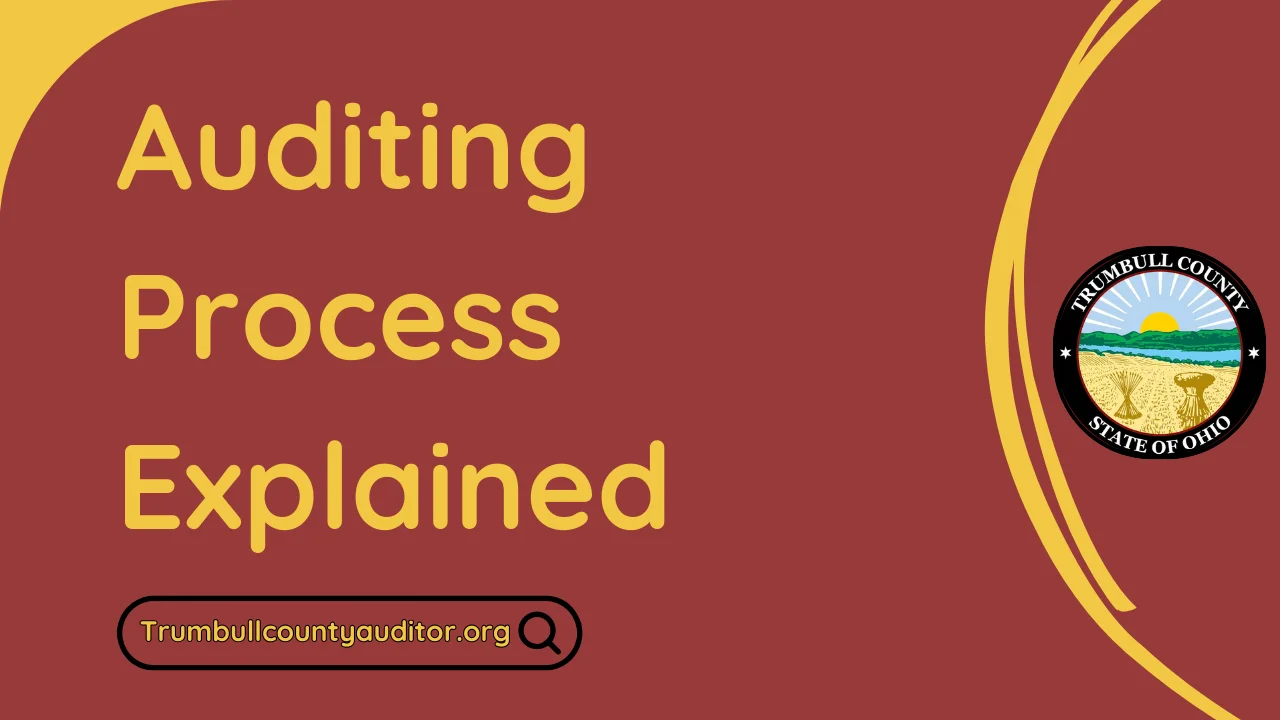The Trumbull County Auditor’s Office is key to keeping finances clear and honest. This article dives deep into how they do it. It covers everything from planning to reporting.
Auditing checks financial statements and controls to spot errors and fraud. It makes sure everything follows the law. This helps build trust and keeps finances in order.
By using strong auditing methods, the Trumbull County Auditor’s Office boosts trust and quality of reports. This article gives a close look at the important work they do. It shows how they keep the county’s finances safe and sound.
Role of County Auditor’s Office
The County Auditor’s Office is key to keeping finances transparent and operations running smoothly. It follows strict laws to do its job well. This includes compliance auditing, financial audits, and operational auditing. These audits help keep the public’s trust in how tax money is spent.
Legal Framework and Responsibilities
The County Auditor’s Office has clear rules to follow. It checks financial statements, makes sure laws are followed, and looks for ways to improve. Its goal is to protect taxpayer money and ensure it’s used wisely.
Importance of Public Sector Auditing
Public sector auditing is vital for trust in government. The County Auditor’s Office checks county programs and finances. It finds problems and suggests fixes, keeping government honest and accountable.
Stakeholder Relationships
The County Auditor’s Office works closely with many groups. This includes government, taxpayers, and regulatory bodies. By working together, the office improves and earns the public’s trust in how tax money is used.
| Key Responsibilities of the County Auditor’s Office |
|---|
| Conducting financial audits to ensure the accuracy and reliability of financial statements Performing compliance auditing to verify adherence to relevant laws, regulations, and policies Undertaking operational auditing to evaluate the efficiency and effectiveness of county programs and services Maintaining voter registration records and administering elections Preserving real property records and serving as the county recorder Overseeing the central accounting system for county government operations Issuing marriage licenses and vehicle/vessel registrations |
Auditing Processes Explained: Core Functions and Procedures
The core auditing process has four main phases: planning, fieldwork, reporting, and follow-up. In the audit planning stage, auditors collect background info, set goals, and make a detailed audit plan. This step is key for gathering audit evidence and testing.
The fieldwork phase is where auditors check internal controls, test transactions, and collect more evidence. They use methods like trend analysis to spot issues. Physical checks, third-party confirmations, and document reviews are top audit procedures for checking controls.
The reporting phase is about writing detailed audit reports and meeting with management. It’s all about clear audit reporting of key risks and suggested fixes. The follow-up phase makes sure these fixes are done on time and any issues are fixed.
| Audit Procedure | Description | Reliability |
|---|---|---|
| Physical Inspection | Examining physical assets, documents, and records | High |
| Third-Party Confirmation | Obtaining verification from external stakeholders | High |
| Document Review | Inspecting organizational records and documentation | High |
Initial Planning Phase in County Audits
The initial planning phase is key in county audits. Auditors carefully look at the organization’s risk, set clear goals, and plan resources. This ensures a thorough and efficient review.
Risk Assessment Methodologies
Rigorous risk assessment is central in the initial phase. Auditors use interviews, inquiries, and analysis to spot risks. This helps pinpoint areas of concern and shapes the audit plan.
Setting Audit Objectives
After understanding the risks, auditors set specific goals. These goals are made to fit the organization’s needs. They focus on financial statements, controls, and compliance. This tailored approach offers insights and suggestions for betterment.
Resource Allocation Strategies
Managing resources well is vital in the initial phase. Auditors use sampling to review financial statements, due to the large number of transactions. The team and timeline are planned to make the audit efficient and on time.
By focusing on these key areas, county auditors set up a detailed and effective audit process. This process gives valuable insights and suggestions to their clients.
Internal Controls and Compliance Measures
Effective auditing in the public sector relies on strong internal controls and compliance measures. These are the policies and procedures that ensure financial reports are accurate and assets are safe. Auditors check if these controls work well to prevent or catch errors or fraud.
Compliance measures make sure laws, regulations, and policies are followed. Auditors test these controls to see how much risk is in financial statements and operations.
Some important parts of internal controls and compliance include:
- Segregation of duties, where different people handle important tasks to avoid conflicts and reduce fraud risk
- Physical controls, like secure storage and limited access, to protect assets
- Information technology general controls (ITGCs), which keep IT systems and data safe
- Continuous control monitoring, using tools to check controls in real-time
- Following laws and regulations, like the Sarbanes-Oxley Act, for accurate financial reports
Strong internal controls and compliance help government entities. They make financial reports reliable, protect public assets, and show a commitment to ethics and transparency.
Financial Statement Review Process
The financial statement review is key in the audit process. It gives limited assurance about a company’s financial records. Unlike a full audit, it checks for any big changes needed to follow financial standards.
Documentation Requirements
Auditors carefully review and document financial records. This includes transactions, balances, and supporting evidence. It makes sure the financial info in statements is accurate and complete.
They must be very detailed. This is because public companies’ financial statements are seen by many people. This includes investors, regulators, and the public.
Analytical Procedures
Analytical procedures are important in the review process. Auditors look at trends, ratios, and data relationships. They check for any odd changes or issues.
These steps help find areas that need more checking or adjustments. This ensures the financial statements truly show the company’s financial health and performance.
Quality Control Standards
Following strict quality control standards is essential. Auditors must stick to set protocols and procedures. This makes their work consistent, reliable, and unbiased.
They also use strong review and approval steps. Plus, they keep detailed records to back up their findings.
In today’s world, auditors face new challenges. These include changes in business, economy, and laws. These changes can raise risks, making auditors need to be more careful and skeptical in their reviews.
| Characteristic | Larger Public Company Audits | Financial Statement Review |
|---|---|---|
| Complexity | Typically more complex | Less complex, focused on material modifications |
| Stakeholders | Used by a wider range of market participants | Targeted at a more limited set of stakeholders |
| Assurance Level | Provides reasonable assurance | Provides limited assurance, typically in the form of negative assurance |
| Cost | Higher, ranging from 20% to 50% of the cost of an audit | Lower, generally 20% to 50% of the cost of an audit |
The review process follows the International Standard on Review Engagements (ISRE) 2400 and the American Institute of Certified Public Accountants (AICPA) Statements on Standards for Accounting and Review Services (SSARS). These standards guide reviews in international and US settings.
Digital Transformation in Auditing Operations
The auditing world is changing fast. New technologies are making audits more efficient and accurate. Auditors need to keep up with these changes.
Intelligent automation and advanced analytics lead this digital change. Auditors use machine learning and artificial intelligence to work smarter. These tools help with data collection, analysis, and reports. They make audits more efficient and help spot risks early.
| Audit Technology Trends | Benefits |
|---|---|
| Data Analytics | Improved accuracy, efficiency, and speed in auditing processes |
| Robotic Process Automation (RPA) | Reduced human error and cost savings |
| Continuous Monitoring | Real-time risk identification and fraud prevention |
| Blockchain Technology | Enhanced document and transaction authentication |
But, there are challenges in this digital shift. Auditors face issues like data security and integrating new tech. Yet, the benefits are clear. Audits are more accurate and efficient, thanks to technology.
Evidence Gathering and Analysis Techniques
Gathering and analyzing audit evidence is key in auditing. Auditors use different sampling methods to pick out parts of data for review. This makes sure the data is accurate and trustworthy. It’s also important to check the data’s authenticity and integrity.
Sampling Methods
Auditors use many sampling techniques to get a fair sample of data. These include:
- Random sampling: This method picks items randomly to avoid bias.
- Stratified sampling: It divides the population into groups and picks samples from each. This makes the sample more representative.
- Systematic sampling: Items are picked at regular intervals to spot patterns.
- Judgmental sampling: This method uses the auditor’s judgment to focus on high-risk areas.
Data Verification Protocols
It’s vital to have good data verification protocols to trust the audit evidence. Auditors use several methods, like:
- Checking information with third parties, like customers or banks, to confirm transactions.
- Doing analytical procedures, like ratio analysis, to find any data issues.
- Rechecking control activities to see if they work well and if data is processed correctly.
Evidence Documentation Standards
It’s important to document audit evidence well. This helps support the auditor’s findings. Auditors follow certain standards for documenting evidence, such as:
| Documentation Requirement | Description |
|---|---|
| Completeness | Recording all needed evidence in the audit papers. |
| Accuracy | Checking that the documented information is correct. |
| Organization | Keeping the evidence organized and easy to find. |
| Accessibility | Making sure the evidence can be easily seen and checked by others. |
By following these steps, auditors can get reliable evidence. This helps them make accurate findings and conclusions. It makes the audit process better and more trustworthy.
Reporting and Communication Protocols
Effective reporting and communication are key in auditing. The final audit report wraps up the audit, covering its scope, goals, results, and how to improve. It’s the main way to share audit findings with the right people.
The report-making starts with a draft. It’s first checked by those in charge. This lets them clear up any doubts before the report is shared more widely. Exit meetings are also important. They let auditors talk about the draft with those who need to know, fixing any last-minute questions.
After the report is finished, it goes to the right people, like the governing body. It includes how management plans to fix the issues found. This openness makes sure everyone knows what to do next.
Good communication is vital in auditing. It helps everyone work together, builds trust, and makes sure audit suggestions are followed. Auditors should be clear, brief, and on point when sharing their findings. They need to speak in a way that fits each group’s needs.
By focusing on clear, quick, and open communication, the audit team can help everyone understand better. This makes solving problems easier and helps the audit succeed.
Cybersecurity Measures in Modern Auditing
In today’s digital world, keeping financial data safe is key. Auditors must protect sensitive information from cyber threats. These threats include malware, social engineering, SQL injections, and zero-day exploits.
Data Protection Standards
Strong data protection standards are vital. They keep financial records and sensitive info safe. Auditors check if data security measures work well. This includes encryption, access controls, and backup plans.
Security Framework Implementation
Using a security framework like NIST’s Cybersecurity Framework helps auditors. It guides them in checking an organization’s cybersecurity. The framework helps ensure the right security steps are taken.
Threat Prevention Strategies
Stopping threats is essential in auditing today. Auditors team up with IT to find and fix vulnerabilities. They also work on preventing cyber attacks. This includes strong access controls, regular testing, and a good incident response plan.



